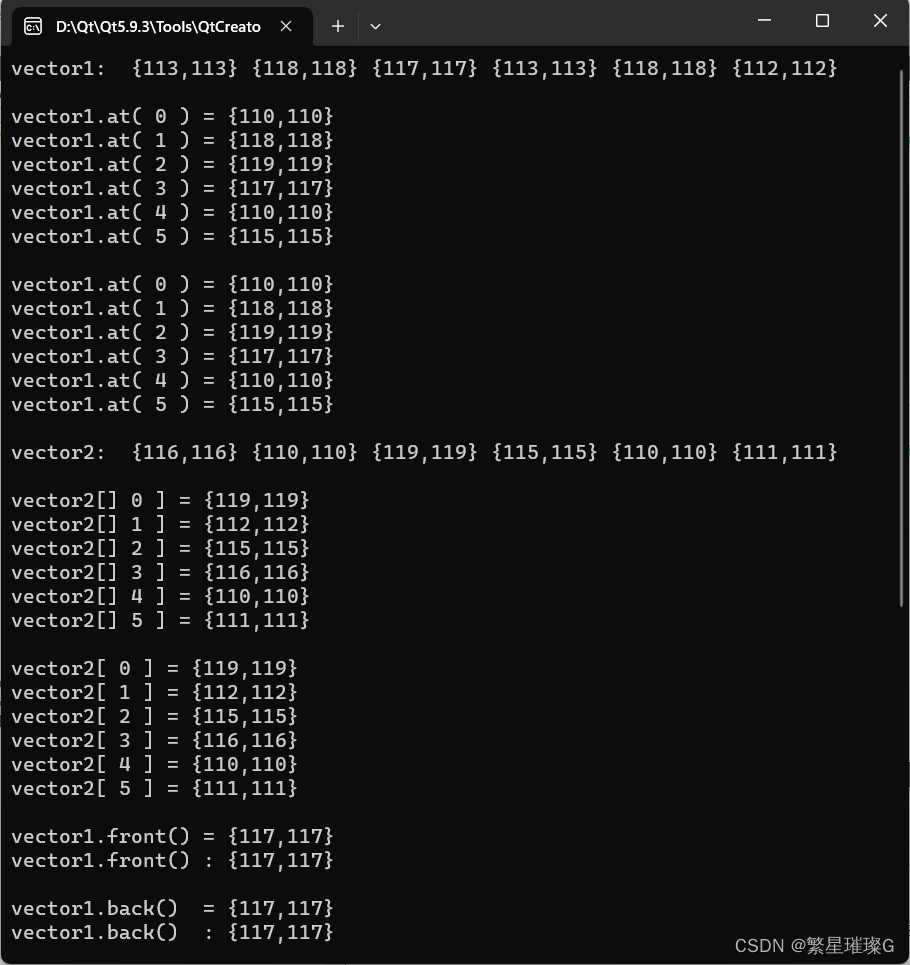c++ 11标准模板(STL) std::vector (四)
定义于头文件 <vector>
| template< class T, | (1) | |
| namespace pmr { template <class T> | (2) | (C++17 起) |
1) std::vector 是封装动态数组的顺序容器。
2) std::pmr::vector 是使用多态分配器的模板别名。
| 元素相继存储,这意味着不仅可通过迭代器,还能用指向元素的常规指针访问元素。这意味着指向 vector 元素的指针能传递给任何期待指向数组元素的指针的函数。 | (C++03 起) |
vector 的存储是自动管理的,按需扩张收缩。 vector 通常占用多于静态数组的空间,因为要分配更多内存以管理将来的增长。 vector 所用的方式不在每次插入元素时,而只在额外内存耗尽时重分配。分配的内存总量可用 capacity() 函数查询。额外内存可通过对 shrink_to_fit() 的调用返回给系统。 (C++11 起)
重分配通常是性能上有开销的操作。若元素数量已知,则 reserve() 函数可用于消除重分配。
vector 上的常见操作复杂度(效率)如下:
- 随机访问——常数 O(1)
- 在末尾插入或移除元素——均摊常数 O(1)
- 插入或移除元素——与到 vector 结尾的距离成线性 O(n)
std::vector (对于 bool 以外的 T )满足容器 (Container) 、具分配器容器 (AllocatorAwareContainer) 、序列容器 (SequenceContainer) 、连续容器 (ContiguousContainer) (C++17 起)及可逆容器 (ReversibleContainer) 的要求。
元素访问
访问指定的元素,同时进行越界检查
std::vector<T,Allocator>::at| reference at( size_type pos ); | ||
| const_reference at( size_type pos ) const; |
返回位于指定位置 pos 的元素的引用,有边界检查。
若 pos 不在容器范围内,则抛出 std::out_of_range 类型的异常。
参数
| pos | - | 要返回的元素的位置 |
返回值
到所需元素的引用。
异常
若 !(pos < size()) 则抛出 std::out_of_range
复杂度
常数。
访问指定的元素
std::vector<T,Allocator>::operator[]| reference operator[]( size_type pos ); | ||
| const_reference operator[]( size_type pos ) const; |
返回位于指定位置 pos 的元素的引用。不进行边界检查。
参数
| pos | - | 要返回的元素的位置 |
返回值
到所需元素的引用。
复杂度
常数。
注意
不同于 std::map::operator[] ,此运算符决不插入新元素到容器。
访问第一个元素
std::vector<T,Allocator>::front| reference front(); | ||
| const_reference front() const; |
返回到容器首元素的引用。
在空容器上对 front 的调用是未定义的。
参数
(无)
返回值
到首元素的引用
复杂度
常数
注意
对于容器 c ,表达式 c.front() 等价于 *c.begin() 。
访问最后一个元素
std::vector<T,Allocator>::back| reference back(); | ||
| const_reference back() const; |
返回到容器中最后一个元素的引用。
在空容器上对 back 的调用是未定义的。
参数
(无)
返回值
到最后元素的引用。
复杂度
常数。
注意
对于容器 c ,表达式 return c.back(); 等价于 { auto tmp = c.end(); --tmp; return *tmp; }
返回指向内存中数组第一个元素的指针
std::vector<T,Allocator>::data| T* data() noexcept; | (C++11 起) | |
| const T* data() const noexcept; | (C++11 起) |
返回指向作为元素存储工作的底层数组的指针。指针满足范围 [data(); data() + size()) 始终是合法范围,即使容器为空(该情况下 data() 不可解引用)。
参数
(无)
返回值
指向底层元素存储的指针。对于非空容器,返回的指针与首元素地址比较相等。
复杂度
常数。
注意
若 size() 为 0 ,则 data() 可能或可能不返回空指针。
调用示例
#include <iostream>
#include <string>
#include <iterator>
#include <algorithm>
#include <functional>
#include <time.h>
#include <vector>
using namespace std;
struct Cell
{
int x;
int y;
Cell() = default;
Cell(int a, int b): x(a), y(b) {}
Cell &operator +=(const Cell &cell)
{
x += cell.x;
y += cell.y;
return *this;
}
Cell &operator +(const Cell &cell)
{
x += cell.x;
y += cell.y;
return *this;
}
Cell &operator *(const Cell &cell)
{
x *= cell.x;
y *= cell.y;
return *this;
}
Cell &operator ++()
{
x += 1;
y += 1;
return *this;
}
bool operator <(const Cell &cell) const
{
if (x == cell.x)
{
return y < cell.y;
}
else
{
return x < cell.x;
}
}
bool operator >(const Cell &cell) const
{
if (x == cell.x)
{
return y > cell.y;
}
else
{
return x > cell.x;
}
}
bool operator ==(const Cell &cell) const
{
return x == cell.x && y == cell.y;
}
};
std::ostream &operator<<(std::ostream &os, const Cell &cell)
{
os << "{" << cell.x << "," << cell.y << "}";
return os;
}
int main()
{
std::cout << std::boolalpha;
std::mt19937 g{std::random_device{}()};
srand((unsigned)time(NULL));
auto generate = []()
{
int n = std::rand() % 10 + 110;
Cell cell{n, n};
return cell;
};
//3) 构造拥有 count 个有值 value 的元素的容器。
std::vector<Cell> vector1(6, generate());
std::generate(vector1.begin(), vector1.end(), generate);
std::cout << "vector1: ";
std::copy(vector1.begin(), vector1.end(), std::ostream_iterator<Cell>(std::cout, " "));
std::cout << std::endl;
std::cout << std::endl;
for (size_t index = 0 ; index < vector1.size(); index++)
{
Cell cell = generate();
//返回位于指定位置 pos 的元素的引用,有边界检查。
//若 pos 不在容器范围内,则抛出 std::out_of_range 类型的异常。
//reference at( size_type pos );
vector1.at(index) = cell;
std::cout << "vector1.at( " << index << " ) = " << cell << std::endl;
}
std::cout << std::endl;
for (size_t index = 0 ; index < vector1.size(); index++)
{
//返回位于指定位置 pos 的元素的引用,有边界检查。
//若 pos 不在容器范围内,则抛出 std::out_of_range 类型的异常。
//const_reference at( size_type pos ) const;
std::cout << "vector1.at( " << index << " ) = "
<< vector1.at(index) << std::endl;
}
std::cout << std::endl;
//3) 构造拥有 count 个有值 value 的元素的容器。
std::vector<Cell> vector2(6, generate());
std::generate(vector2.begin(), vector2.end(), generate);
std::cout << "vector2: ";
std::copy(vector2.begin(), vector2.end(), std::ostream_iterator<Cell>(std::cout, " "));
std::cout << std::endl;
std::cout << std::endl;
for (size_t index = 0 ; index < vector2.size(); index++)
{
Cell cell = generate();
//返回位于指定位置 pos 的元素的引用。不进行边界检查。
//reference operator[]( size_type pos );
vector2[index] = cell;
std::cout << "vector2[] " << index << " ] = " << cell << std::endl;
}
std::cout << std::endl;
for (size_t index = 0 ; index < vector2.size(); index++)
{
//返回位于指定位置 pos 的元素的引用。不进行边界检查。
//const_reference operator[]( size_type pos ) const;
std::cout << "vector2[ " << index << " ] = "
<< vector2[index] << std::endl;
}
std::cout << std::endl;
//返回到容器首元素的引用。在空容器上对 front 的调用是未定义的。
Cell cell = generate();
vector1.front() = cell;
std::cout << "vector1.front() = " << cell << std::endl;
std::cout << "vector1.front() : " << vector1.front() << std::endl;
std::cout << std::endl;
//返回到容器中最后一个元素的引用。在空容器上对 back 的调用是未定义的。
vector1.back() = cell;
std::cout << "vector1.back() = " << cell << std::endl;
std::cout << "vector1.back() : " << vector1.back() << std::endl;
std::cout << std::endl;
for (size_t index = 0; index < vector1.size(); index++)
{
//返回指向作为元素存储工作的底层数组的指针。
//指针满足范围 [data(); data() + size()) 始终是合法范围,
//即使容器为空(该情况下 data() 不可解引用)。
//T* data() noexcept;
Cell cell = generate();
*(vector1.data() + index) = cell;
std::cout << "vector1: " << (vector1.data() + index)
<< " = " << cell << std::endl;
}
std::cout << std::endl;
for (size_t index = 0; index < vector1.size(); index++)
{
//返回指向作为元素存储工作的底层数组的指针。
//指针满足范围 [data(); data() + size()) 始终是合法范围,
//即使容器为空(该情况下 data() 不可解引用)。
//const T* data() const noexcept;
std::cout << "vector1: " << (vector1.data() + index) << " : "
<< *(vector1.data() + index) << std::endl;
}
return 0;
}输出

